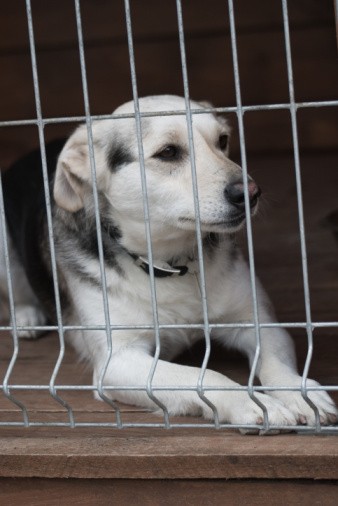Was your dog really abused?
By Michele Welton, Dog Trainer, Breed Selection Consultant, Author of 15 Dog Books

Abused or not? In my experience, people are far too quick to label a dog as "abused" simply because he's in a rescue group or shelter, or because the dog has temperament flaws or behavior problems.
"Please help! My poor rescue dog is scared of men and kids and loud voices – I'm sure he was horribly abused."
Trainers and behavioral consultants hear this all the time. It's common for dog lovers to immediately diagnose "abuse" whenever a dog is anxious or fearful or shies away from certain people.
People who have suffered some form of abuse themselves are the quickest to label dogs as such. By and large, these people grossly overestimate their ability to recognize symptoms of abuse in dogs.
Of course there are dogs out there who have suffered physical abuse, even horrific mutilations. But it's much more likely that if abuse occurred at all, it was mental or psychological rather than physical.
And in most of these cases, it isn't so much what DID happen to the dog... but rather, what DIDN'T happen (but should have).
Let me explain. It's up to a dog's breeder to provide good genetics. It's up to a dog's owners (past and current) to provide proper socialization and leadership. If any of these is done poorly, the resulting dog can look very much like one who was physically beaten.
How poor socialization/leadership/genetics can look like abuse
- Lack of socialization. When a dog isn't taken out into the world during his formative months to see lots of new things, he is less likely to be confident about the world. Such a dog often reacts with anxiety, wariness, shyness, or aggression because he doesn't have the foundational confidence that would have been instilled by proper socialization.
So lack of socialization is a perfectly plausible reason for why a dog acts fearful or aggressive.
- Lack of leadership. When a dog encounters something in the world that makes him feel concerned, his leader needs to immediately step in and show the dog how to behave in that situation. No nervous woofing allowed. No barking or lunging allowed. Loose leash required. Calmness required. If the owner doesn't provide that firm guidance and direction, the dog might react instinctively – the classic fight or flight response.
So lack of leadership is a perfectly plausible reason for why a dog acts fearful or aggressive.
- And then there are bad genes. Dogs can inherit what we call "weak nerves" or
hyper-reactivity to normal sights, sounds, and movements. These dogs are quick to startle or flinch. Some cringe and cower, or shiver and shake, when they see or hear something that other dogs handle with confidence. Unfortunately, genetic-based temperament issues can be both persistent and resistant, because you can't change the genes the dog inherited.
So inheriting genes for a weak temperament is a perfectly plausible reason for why a dog acts fearful or aggressive.
Now, don't misunderstand... everything in the list above IS psychologically and emotionally harmful or "abusive" to a dog. His ability to live comfortably in the world, to cope with new places and situations without stress, is damaged when the people in his life fail to provide him with good genetics, socialization, and leadership.
But physical abuse is much less common than you might think. So there's no need to cling to speculation that your dog "must have been beaten" as an excuse for his aggression or fearfulness. It's much more likely that he simply wasn't bred or raised properly.
And at this point, the cause doesn't even matter.
Dogs aren't into psychoanalysis. So your feeling sorrowful about your dog's (real or imagined) past doesn't help him at all. His past is over. Move forward. Let him know, with consistent rewards and corrective techniques, which behaviors you want and which behaviors are unacceptable.
Calm leadership is what your pup wants and needs, no matter what his age, no matter what his breed, no matter what his "back story" is.
Establishing crystal-clear behavioral guidelines (Yes and No) and backing those up with calm, consistent leadership is exactly how you show your pup that you love him... whether he comes from the best breeder in the world, or from the worst abusive hell-hole. The road forward is exactly the same.
My best-selling books – now available FREE on my website
 Respect Training For Puppies: 30 seconds to a calm, polite, well-behaved puppy is for puppies 2 to 18 months old. Your puppy will learn the 21 skills that all family dogs need to know. Click here to read for free.
Respect Training For Puppies: 30 seconds to a calm, polite, well-behaved puppy is for puppies 2 to 18 months old. Your puppy will learn the 21 skills that all family dogs need to know. Click here to read for free. Teach Your Dog 100 English Words is a unique Vocabulary and Respect Training Program that will teach your adult dog to listen to you and do what you say. Click here to read for free.
Teach Your Dog 100 English Words is a unique Vocabulary and Respect Training Program that will teach your adult dog to listen to you and do what you say. Click here to read for free. 11 Things You Must Do Right To Keep Your Dog Healthy and Happy helps your dog live a longer, healthier life. Get my honest advice about all 11 Things before you bring home your new puppy, because some mistakes with early health care cannot be undone. Click here to read for free.
11 Things You Must Do Right To Keep Your Dog Healthy and Happy helps your dog live a longer, healthier life. Get my honest advice about all 11 Things before you bring home your new puppy, because some mistakes with early health care cannot be undone. Click here to read for free.
